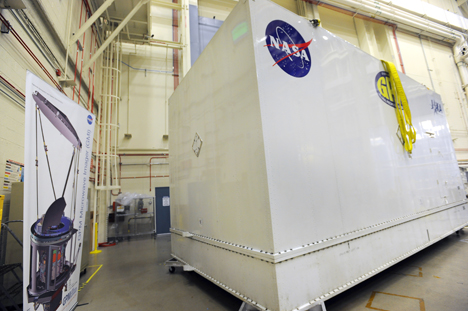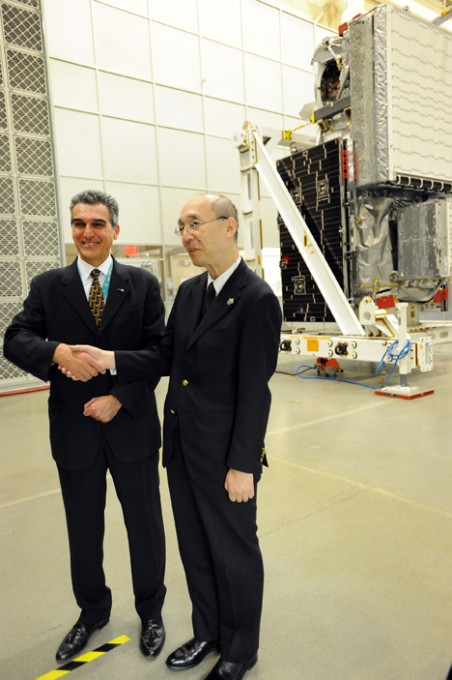
The shipping container that will carry GPM to Japan. Comes complete with environmental regulation to keep the humidity and temperature just right for the spacecraft. Credit: NASA
Right now if you want to take a look at the Global Precipitation Measurement mission’s Core Observatory, you can’t. As of last weekend, it’s sealed up inside a giant white shipping container, all prepped for its long journey to Japan where it will launch in early 2014.
This isn’t your typical satellite delivery. As Project Manager Art Azarbarzin says, we’re not just driving by truck across a couple states to a U.S. launch site. GPM will be traveling by truck to an Air Force C5 cargo plane which will fly it over the United States and the Pacific Ocean to Japan. Once at the airport on Kyushu, it will be transferred to a barge that will take it to Tanegashima Island, where NASA’s mission partners, the Japan Aerospace Exploration Agency, or JAXA, have their spaceport.
My bags are packed too. As the science writer for the GPM mission, I’ll be traveling with the satellite and the engineering team that’s accompanying the spacecraft. getting the behind the scenes story of GPM’s road trip. I’ll be sending back photos and stories of each leg of the journey, and once we arrive, introduce you to living and working Tanegashima, Japan.

NASA’s GPM Project Manager Art Azarbarzin (left) and JAXA’s GPM Project Manager Masahiro Kojima in front of the GPM satellite at its last public appearance on Nov 15, 2013. Credit: NASA
Every satellite’s shipment to the launch site is a big moment, but for GPM it feels especially poignant because the spacecraft was built and tested in-house at Goddard Space Flight Center. Over 300 people worked on it here, and have seen it come together day by day. At our recent Friends and Family Day, the energy of the team was palpable as they shared their excitement for the mission and the satellite they had built together with their loved ones.
For me, the second story I wrote when I began working at Goddard was about testing part of the frame for the body of the GPM spacecraft on Goddard’s high capacity centrifuge. Since then I’ve covered both the engineering milestones and stories about the science GPM will do to improve rain and snowfall measurements from space, as well helped the science team share their work on field campaigns like the Iowa Flood Studies in preparation for GPM’s launch.
That launch is almost here is a little surreal but I’m very excited as we begin this final phase before liftoff. Stay tuned.



